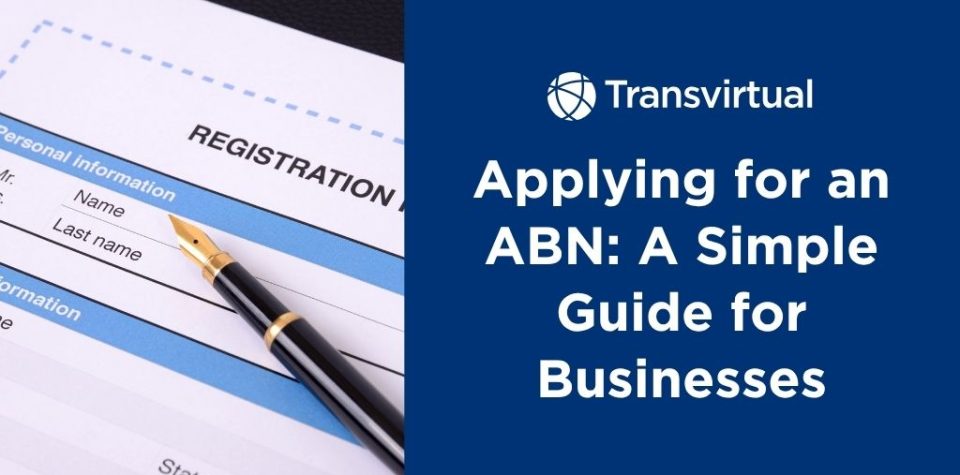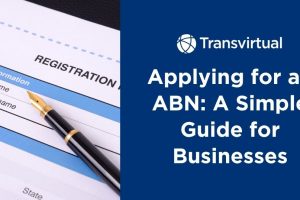Table of Contents
If you’re setting up a new business in Australia, there’s no way around getting an ABN.
No matter if you’re launching a large scale logistics operation, running a small side hustle, or exploring a new venture aside from your existing business, you need to register for an ABN if you are operating a business as a legal entity, such as a company or partnership.
Securing an ABN is one of your first steps. You can apply for an ABN using the online application form available through the Business Registration Service. The Business Registration Service is a government platform that allows you to register for an ABN and other business registrations in one place, making it convenient for new business owners. The online application form is straightforward and can be completed quickly. Fortunately, it’s not a complicated process, but it definitely helps to know what to expect before you get started.
What is an ABN and why does it matter?
An ABN (Australian Business Number) is a unique identifier given to businesses by the Australian Business Register (ABR). It’s almost like a fingerprint for your business, which can be used by government agencies, your clients, and even software platforms to know who they’re dealing with. For example, when you issue an invoice, your ABN is used to confirm your business identity and ensure compliance with tax regulations.
ABN’s are necessary to:
Register for GST (as long as you exceed the $75,000 threshold)
Send invoices that are tax-compliant. If you do not include your ABN on invoices, tax may be withheld from your payments by the payer.
Claim GST credits or fuel tax credits
Register a business name. For example, if your name is John Smith and you operate as “John Smith,” you may not need to register a business name, but if you trade as “Smith Consulting,” registration is required.
Open accounts for your business and apply for financing
Work with suppliers, particularly in freight/transportation industries
You can still do business without an ABN, but it’ll be messy. You might need to withhold tax at the top marginal rate when being paid. Also, your clients could see you as less credible than your competitors.
Choosing a Business Name
Selecting the right business name is a foundational step in building your Australian business identity. Your business name is how customers, the Australian Taxation Office, and other government agencies will identify your registered business. When brainstorming a proposed business name, aim for something unique, memorable, and easy to spell.
Before you settle on a name, check its availability using the Australian Securities and Investments Commission (ASIC) business name search tool. This helps ensure your proposed business name isn’t already registered or too similar to existing business names, and that it doesn’t infringe on any existing trade marks.
Taking these steps early will help you avoid legal issues and ensure your business stands out in the marketplace.
Business Structure Considerations
The most common business structures include sole trader, partnership, company, and trust, each with its own set of responsibilities and benefits.
As a sole trader, you can operate under your own name or register a business name, but you’ll need to apply for an Australian Business Number (ABN) and a tax file number (TFN).
If you decide to operate as a company, you must register with the Australian Securities and Investments Commission (ASIC) and obtain an ABN for your company.
Your chosen business structure will affect your tax registrations, such as goods and services tax (GST) and pay-as-you-go (PAYG) withholding, as well as your legal obligations and how you pay tax. It’s important to consider your long-term business goals and seek professional advice if you’re unsure which structure best suits your needs.
The right structure will help you register your business efficiently and ensure you meet all regulatory requirements in Australia.
Registering Your Business Details
Once you’ve decided on your business structure and name, the next step is registering your business details. You’ll need to apply for an Australian Business Number (ABN) through the Australian Business Register (ABR) website. Your ABN is a unique 11-digit number that identifies your business to the government, other businesses, and the public.
During the registration process, you can also apply for other tax registrations, such as GST and PAYG withholding, through the Australian Taxation Office (ATO).
It’s essential to provide accurate and up-to-date business details when registering, as this information is used by government agencies and other businesses to verify your business identity. Keeping your business details current with the Australian Business Register (ABR) will help you avoid issues with tax registrations and ensure your business remains compliant with government requirements.
Am I eligible for an ABN right now?
Most people looking to start a business in Australia are eligible for an ABN. Applying for an ABN involves meeting certain requirements, such as providing accurate business details and understanding its importance for tax and invoicing purposes. Here’s who typically applies and qualifies:
Sole traders (freelancers, contractors, owner-operators)
Partnerships
Companies
Corporations
Joint ventures
Trusts
Other business structures, such as partnerships and companies, have specific requirements for ABN and TFN registration.
But not every activity counts, and you must be officially “carrying on or starting an enterprise.” This means you can’t just have a business name idea or print a few flyers to test the waters. You need to be actively advertising or offering services. You should have a business plan, a website, or a general operational structure, and you must show intent to make a profit from your services.
If these don’t apply to you, the ATO won’t be convinced that you’re set up to operate your business, and your application could be rejected. That’s why it’s important you have a clear picture of your business going forward, even if it’s still the early days.
The ABN application process
The Australian Business Register (ABR) enables business to secure their ABNs free and through their online portal. The process itself only takes about 15 minutes, and in most cases the number is issued immediately. After submitting your application, you will receive a reference number, which you can use to track the status of your application.
Here’s everything you’ll need before you get started:
Your Tax File Number (TFN), or the TFNs of partners or directors
Details about your business structure (sole trader, company, partnership, etc.)
A business address and contact details
A description of business activities
Expected start date
Whether you plan to register for GST
The ABR will take this information into consideration and determine your eligibility. You should be approved if you’re genuinely starting or carrying on an enterprise. As long as your details are accurate and complete, you can expect instant approval. However, your application might be flagged for a manual review, which could take up to 20 business days.
If your business details change, such as your address or contact information, it is important to update the ABR promptly to ensure your records remain accurate.
Why was my ABN application denied?
In some cases, an application for an ABN is refused. It may be frustrating, but don’t panic.
Here are the most common reasons why ABNs are rejected:
Your business activity appears to be more of a hobby, not a true enterprise
Your business structure doesn’t match the details you provided
The information you provided (your TFN or business address) does not align with ATO records
If any of these apply to your case, you’ll receive a refusal number and a written explanations. Usually, you can reapply immediately after you correct the issue. That means you’ll need to reword your activity description to better reflect a commercial intent or select the correct structure for your business.
Don’t rush your application. If you label yourself incorrectly (as a sole trader when you plan to register as a company, etc.), it can create serious headaches later. If you aren’t sure, speak to an accountant or a business advisor first.
What’s next after I receive my ABN?
Getting your ABN is your first step toward being able to run your business efficiently and legally. Here are the next best steps to take:
Register for GST if your turnover will exceed $75,000 or if you want to voluntarily register earlier
Register your business name through ASIC if you plan to trade under anything other than your legal name. You can visit the ASIC business name registration page to complete this process.
Create a business bank account to keep your finances clean and separated
Organise your record keeping process and invoicing systems. Make sure they’re totally compliant!
Connect your ABN to your key software platforms (accounting tools, payroll systems, and your TMS if you’re in the transportation or logistics industry)
For added convenience, you can use the Australian Government’s Business Registration Service to manage multiple registrations, such as your ABN, business name, and GST, all in one place.
Protecting Your Business Identity
Safeguarding your business identity is vital for building trust and credibility in the Australian market. One of the best ways to protect your business name is by registering it as a trade mark through IP Australia. This legal protection prevents other businesses from using a similar name and helps you establish a distinct brand presence.
Make sure your registered business name and ABN are clearly displayed on all official documents, such as invoices and receipts, to reinforce your business identity. Additionally, you can use the ABN Lookup tool to verify the legitimacy of other businesses before entering into agreements, ensuring you’re dealing with registered businesses. Taking these steps will help you protect your business and maintain a strong, reputable presence in Australia.
Smoothing out the road ahead
You’ve now ticked one of the most important government boxes and taken a huge official step into the business world.
Now that you’re a legitimate business, you have access to a wide range of tools that will make your life and your business operations much easier.
If you’re in the logistics or delivery space, software platforms like Transvirtual are here to help you get serious about your operations. You’re all set up to start automating deliveries, managing freight jobs, and building a logistics workflow that scales effortlessly as you grow. We’ve created a step-by-step guide to help you launch your courier business.


